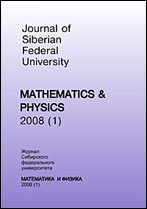|
|
Journal of Siberian Federal University. Mathematics & Physics, 2010, Volume 3, Issue 1, Pages 125–132
(Mi jsfu111)
|
 |
|
|
This article is cited in 1 scientific paper (total in 1 paper)
Theoretical Investigation of Transition Metals Interaction with Silicon (001) Surface
Alexander A. Kuzubova, Tatyana A. Kojevnikovaa, Alexander S. Fedorovb, Pavel O. Krasnovc, Zaxar I. Popovb
a Siberian Federal University, Krasnoyarsk, Russia
b Kirensky Institute of Physics, SB RAS, Krasnoyarsk, Russia
c Siberian State Technological University, Krasnoyarsk, Russia
Abstract:
Interaction of cobalt and iron atoms with (001) surface of silicon is modeled using ab-initio calculations. The most favorite positions of cobalt and iron atoms on silicon surface are determined. It is shown that the most favorite positions are the subsurface (UD) atom positions where metal atoms sit under silicon dimer centers. The migration paths of the metal atoms on the silicon surface and into the subsurface positions are calculated. Using binding energy analysis it is shown that metal binding energy is decreased at 0.85 eV for cobalt and at 0.90 eV for iron cases while the metal concentration is increased from separate metal atoms to fully filled metal double layer at the silicon surface. Calculations of structures with fully filled single metal layer at the surface and structures where the both surface and subsurface metal positions are filled are show that the most favorable are the structures with single filled layer where the metal atoms sit in symmetrical position between two dimers of one row and the system with metal atoms inside the UD layer.
Keywords:
surface physical chemistry, surface reconstruction, ab-initio calculations, silicon, silicide.
Received: 10.12.2009
Received in revised form: 15.01.2010
Accepted: 10.02.2010
Citation:
Alexander A. Kuzubov, Tatyana A. Kojevnikova, Alexander S. Fedorov, Pavel O. Krasnov, Zaxar I. Popov, “Theoretical Investigation of Transition Metals Interaction with Silicon (001) Surface”, J. Sib. Fed. Univ. Math. Phys., 3:1 (2010), 125–132
Linking options:
https://www.mathnet.ru/eng/jsfu111 https://www.mathnet.ru/eng/jsfu/v3/i1/p125
|

| Statistics & downloads: |
| Abstract page: | 337 | | Full-text PDF : | 97 | | References: | 34 |
|




 Contact us:
Contact us: Terms of Use
Terms of Use
 Registration to the website
Registration to the website Logotypes
Logotypes







 Citation in format
Citation in format 
